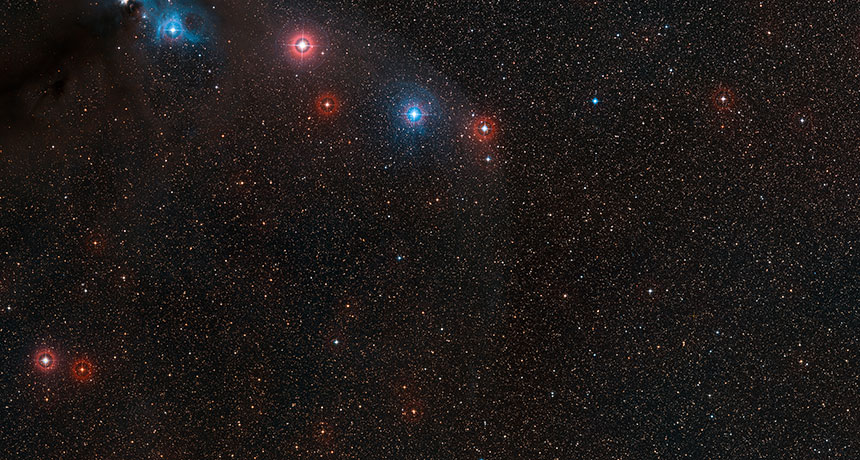Weird physics warps nearby star’s light
Neutron star offers first sign of bizarre effect of quantum physics — one first predicted 80 years ago

A star in the constellation of Corona Australis (shown) is helping scientists study a bizarre feature of quantum physics. The star’s light is too faint to be seen in this image. But its light has been twisted in a way that offers evidence of the bizarre quantum effect.
ESO, DIGITIZED SKY SURVEY 2
A nearby star is helping scientists study a bizarre effect of physics that occurs on the smallest of scales. The effect is called “vacuum birefringence.” It was predicted 80 years ago. But until now, scientists had never seen signs of it.
A magnetic field is what allows magnets to attract or repel one another. Vacuum birefringence describes how light interacts with the emptiness of space — when that space is under the influence of a strong magnetic field.
Researchers think they observed this long-anticipated effect in the light of a neutron star. That’s a star that exploded in a fiery death, leaving behind only a dense core. That stellar remnant sits about 400 light-years from Earth. Light from this star has been warped in a way that scientists now think points to vacuum birefringence. They described their finding in a paper to be published in the February 11 issue of the Monthly Notices of the Royal Astronomical Society.
“It’s the most natural explanation,” says Jeremy Heyl. He is an astrophysicist at the University of British Columbia in Vancouver, Canada. Heyl was not involved with the new study. It showed that the light of the neutron star is slightly polarized. That means all of the light waves wiggle on the same plane. This is the first time scientists have seen polarized light from a star that could be a sign of vacuum birefringence. The detection is helping scientists to study quantum physics.
What excites scientists
Quantum physics describes how matter and energy behave at the level of atoms or even smaller particles. With the light of the neutron star, scientists can test their ideas about a theory in quantum physics known as quantum electrodynamics. This theory describes how light interacts with charged particles such as electrons. The theory states that empty space isn’t really empty. It is filled with a roiling soup of particles, which constantly blip into and out of existence. As light passes through space, its wiggling electromagnetic waves may interact with those particles.
Strong magnetic fields influence how the waves move. Light waves that wiggle along the direction of the magnetic field will travel slightly more slowly than light that wiggles perpendicular to the direction of the magnetic field. This difference in speed polarizes the light coming from the star.
A similar effect can happen in a more familiar situation. It occurs in what are known as birefringent materials. The liquid crystals used for displaying images on some computer monitors and TVs offer one example. They can rotate the polarization of light. Horizontally polarized light, for example, is sent to each pixel on the display screen. But a filter lets only vertically polarized light escape. To switch on a pixel, the liquid crystals twist the light waves 90 degrees. That allows the waves to pass through.
That’s a classical version of the birefringent effect.
Evidence for the quantum version has not been so easy to come by. Observing it requires a magnetic field stronger than those that can be produced in the laboratory, says Roberto Mignani. He is an astrophysicist at the National Institute for Astrophysics in Milan, Italy. The magnetic field around the neutron star that he and his colleagues studied is about 10 trillion times the strength of Earth’s. But the star is incredibly faint. “
A neutron star of this kind is about as bright as a candle halfway between the Earth and the moon,” Mignani explains. That makes detecting its light difficult. And it makes measuring the polarization of its light even more of a challenge.
To detect the star’s light, Mignani and his team used the Very Large Telescope in Chile. The scientists found that visible light from the neutron star was about 16 percent polarized. This result is consistent with scientists’ theories of vacuum birefringence. But other things could twist the light, too, Heyl notes. Plasma, for example.
Plasma is a gaseous form of matter. There are lots of positively and negatively charged particles floating about in that form of gas. An unexpectedly large amount of plasma surrounding a star could polarize its light. And, the plasma could do it in a way that looks like vacuum birefringence, Heyl notes.
As a result, scientists need more airtight evidence to prove the quantum effect. They could study X-rays from neutron stars. In those wavelengths of light, the polarization effect should be even stronger. No telescope currently exists to make such measurements. But there are several proposed X-ray satellites that may soon be able to clinch the case for vacuum birefringence.
Scientists might want to keep their fingers crossed. Future measurements could overturn the evidence for vacuum birefringence. That would cause problems for the theory of quantum electrodynamics. Vacuum birefringence is one basic prediction of the theory, Heyl says. “So to fix it, you’d really have to rip the theory all the way back down to the foundations and rebuild it.”







